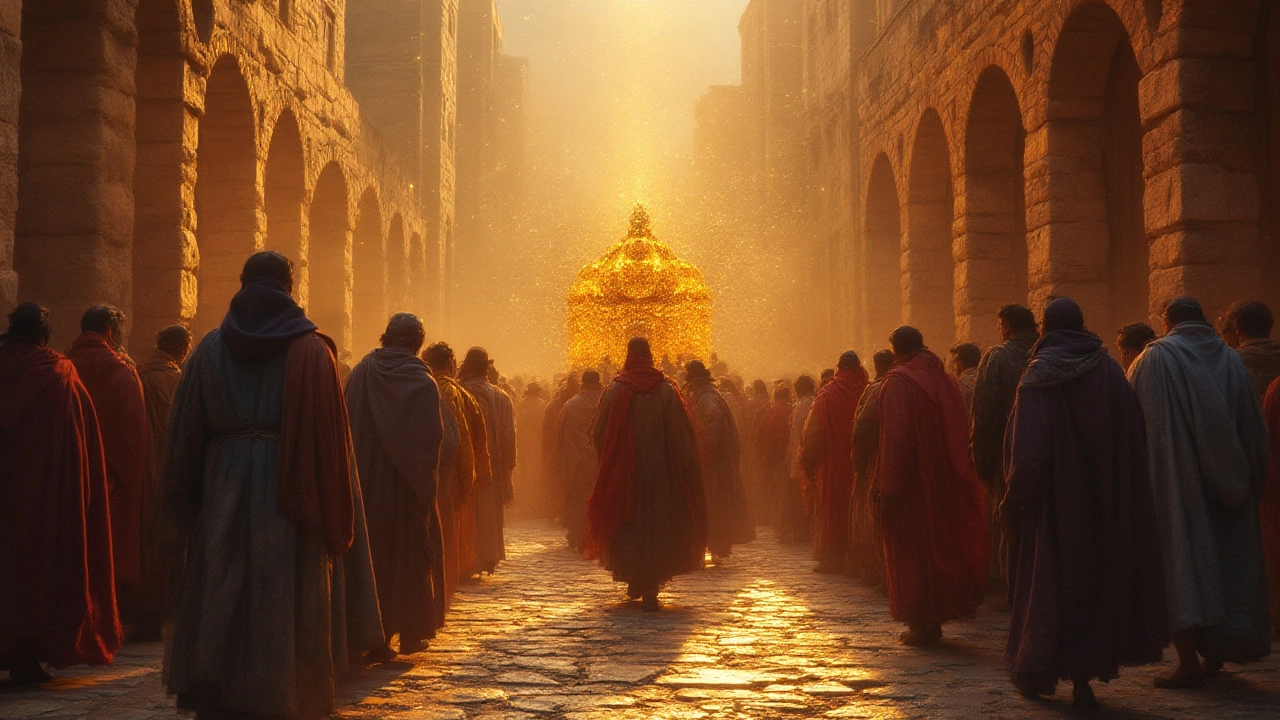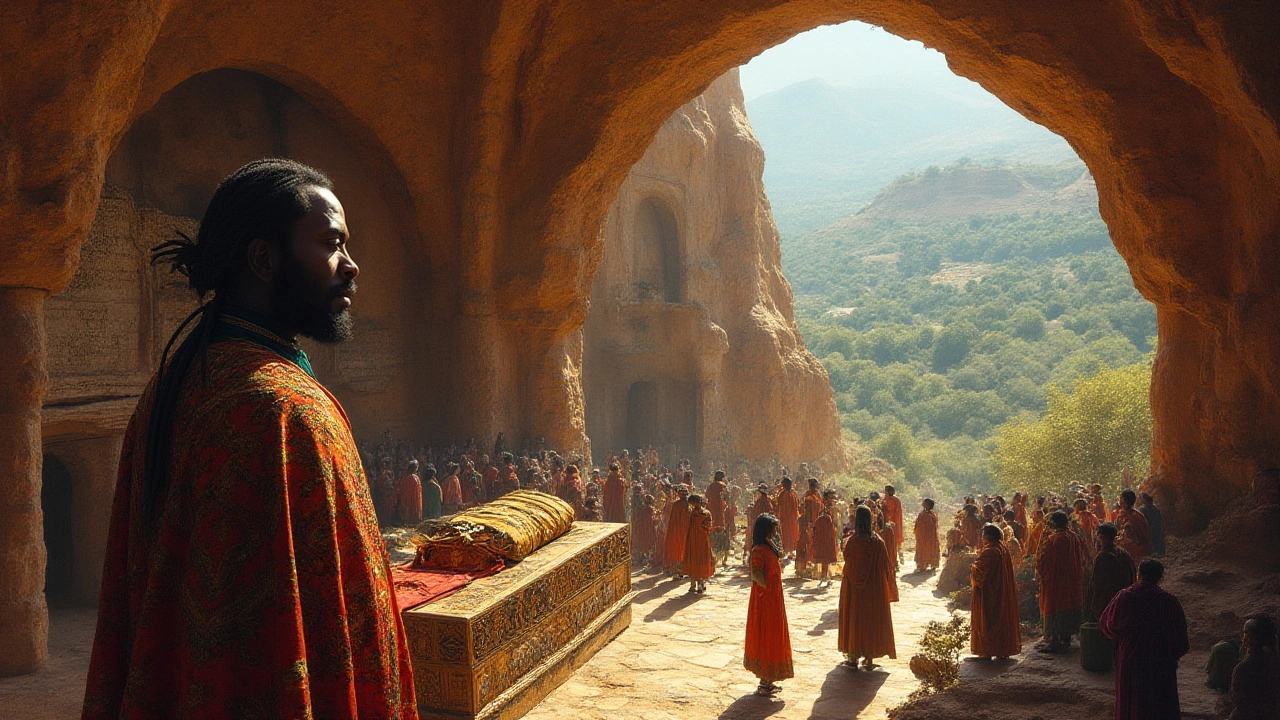Ark of the Covenant: Tracing History and Theories About Its Whereabouts
 Jul, 17 2025
Jul, 17 2025
Picture this: legend says the most sacred, electrically charged golden box in religious history went missing thousands of years ago—and people are still obsessed. The Ark of the Covenant fires up the imagination in a way few ancient objects do. Raiders in pop culture have chased it (thanks, Indiana Jones), but scholars, treasure hunters, and theologians have been at it for centuries. So, where the heck is it now? Did it ever really exist? Or is it still out there, tucked away in some dusty chamber while the world argues over its fate?
The Ark’s Story: More Than Just A Lost Relic
Let’s back up. The Ark of the Covenant, according to the Hebrew Bible, was built at the foot of Mount Sinai to house the original stone tablets of the Ten Commandments. It’s no exaggeration: this chest was a centerpiece in the beliefs and ceremonies of ancient Israel. It wasn’t just spiritual bling—it was supposed to guarantee victory in battle, show God's power, and anchor the Jewish faith.
Built of acacia wood and covered in pure gold, the Ark measured about 1.1 meters long, 0.7 meters wide, and 0.7 meters high—roughly the size of a trunk you could fit in a modern-day SUV. Its famous lid, the Mercy Seat, topped with gold cherubim, was thought to be God’s literal footstool on Earth. Serious business.
The Israelites kept the Ark in the Holy of Holies, the innermost sanctuary of the Tabernacle—and later the Temple in Jerusalem, built by Solomon around 957 BCE. It played leading roles in legendary moments: the walls of Jericho crumbling, plagues upon thieves, and strange tales of deadly divine power. Everything changed when Jerusalem fell to the Babylonians in 586 BCE. The Ark—like so many treasures—vanished. The Bible offers no final answer. At best, it goes radio silent. Theories, however, are like weeds—they never stop growing.

Contenders and Clues: Where Do People Think the Ark Ended Up?
Let’s follow the trail. Since the day it disappeared, historians and adventurers have chased rumors scattered across continents.
- Babylonian Conquest: Some believe the Ark was destroyed or carted off to Babylon. But Babylonian records, which have detailed loot lists from Jerusalem—including temple menorahs—say nothing about the Ark. That silence fans the flames of speculation.
- Hidden in Jerusalem: Scrolls like the Second Book of Maccabees hint the prophet Jeremiah stashed the Ark in a cave on Mount Nebo, now in modern-day Jordan, right before the Babylonian siege. Conflicting Jewish legends say it might remain beneath the Temple Mount, buried in secret tunnels or chambers. Archaeological digs under the mount are forbidden, so we’re left guessing.
- Egyptian and Ethiopian Theories: Things get truly wild with claims the Ark was whisked out of Jerusalem and taken far south. Ethiopian Orthodox Christians are adamant it was brought to Aksum, in present-day Ethiopia, 3,000 years ago by Menelik I—the son King Solomon supposedly had with the Queen of Sheba. They even claim to house the Ark in a chapel next to the Church of St. Mary of Zion. A single guardian is allowed to see it. No outsider has ever laid eyes on their relic, which only deepens suspicion and curiosity.
- Other Claims: Some fringe theories place the Ark everywhere from southern Africa to Ireland, even hidden in European cathedrals. But outside Ethiopia and Jerusalem, these trails are built almost entirely on wishful thinking—not even a crumb of hard evidence.
People have spent millions—seriously, millions—on searches. Israeli archaeologists have combed every accessible inch of Jerusalem. Ron Wyatt, a self-styled American explorer, claimed in 1982 that he’d found the Ark beneath the Temple Mount. His evidence? Some photos and stories, but no peer-reviewed proof. The Ethiopia claim, meanwhile, has UNESCO recognizing the site’s cultural value, but their “no photograph, no entry” policy leaves most experts rolling their eyes.
| Ark Location Claim | Main Evidence | Independent Verification? |
|---|---|---|
| Babylon (Iraq) | Biblical timing—lack of loot records | No |
| Mount Nebo (Jordan) | Ancient religious writings | No excavations |
| Temple Mount (Jerusalem) | Jewish oral tradition | Excavation forbidden |
| Aksum (Ethiopia) | Ethiopian Orthodox tradition | Restricted access |
| Europe (Ireland, France etc.) | Theories, myths | None |
One fact rarely gets mentioned: If the Ark ever existed, and survived the city’s sieges, its gold alone would have tempted conquerors. Yet not a splinter or gold fragment has turned up where you’d expect. Electrical engineers, too, have tested the idea that the Ark could actually deliver deadly shocks, given its construction and ancient claims. Turns out, the pure gold and wood sandwich would make one heck of a capacitor in the right conditions. Still, no zapped archaeologists have brought us proof from the field yet.

The Ark’s Legacy: What It Means Today
All this mystery changes how people see the Ark even in our tech-saturated era. The lost-forever vibe has supercharged everything from blockbuster movies to pseudo-scientific TV specials that mix fact, fiction, and wild speculation. The Ark inspires religious awe, but it also launches a thousand Indiana Jones knock-off plots.
Real-life religious ceremonies referencing the Ark continue in Ethiopia. Each year, hundreds of thousands crowd into Aksum during the festival of Timket, when a replica (not the actual Ark, of course) is paraded through the streets, covered and guarded, but never revealed. For the faithful, the power of the Ark is alive, whether scholars scoff or not.
Meanwhile, in Jerusalem, political and religious tensions make it almost impossible to dig up the Temple Mount and settle the question. Even the hint that someone is searching for the Ark in or under the Mount can spark global headlines and diplomatic headaches.
What should regular folks take from this? If you’re chasing ancient mysteries, know you’ll probably end up with a pile of good stories, not a golden treasure chest. If you want real-world adventure, travel to Aksum and soak in the ritual—but don’t expect a secret unveiling. If you’re a Bible buff, the Ark is a reminder of how history and myth can blur. My dog Toby probably believes the Ark’s just another missing stick—frankly, that’s as likely as any theory we’ve got.
Here’s the best tip for Ark enthusiasts: look at verified discoveries in the region. Read up on the Dead Sea Scrolls and the copper scroll found at Qumran, which actually lists temple treasures buried for safekeeping. Join archaeological tours of Jerusalem’s ancient tunnels and ramparts. True, nobody has found the Ark. But the real world is full of tangible relics, crumbled ruins, and artifacts that do tell stories of faith, migration, and loss.
If you’re itching to solve the Ark’s riddle yourself, brush up on ancient languages and biblical geography. Most real archaeologists start their careers in the library, not the jungle. The search, as they say, is often more important than the end prize—especially when the end prize might be more legend than gold. Until someone wheels the gold-laden chest out for the cameras, the Ark sits at the crossroads of faith, legend, and our wild search for answers. And maybe, just maybe, that’s exactly where it belongs.